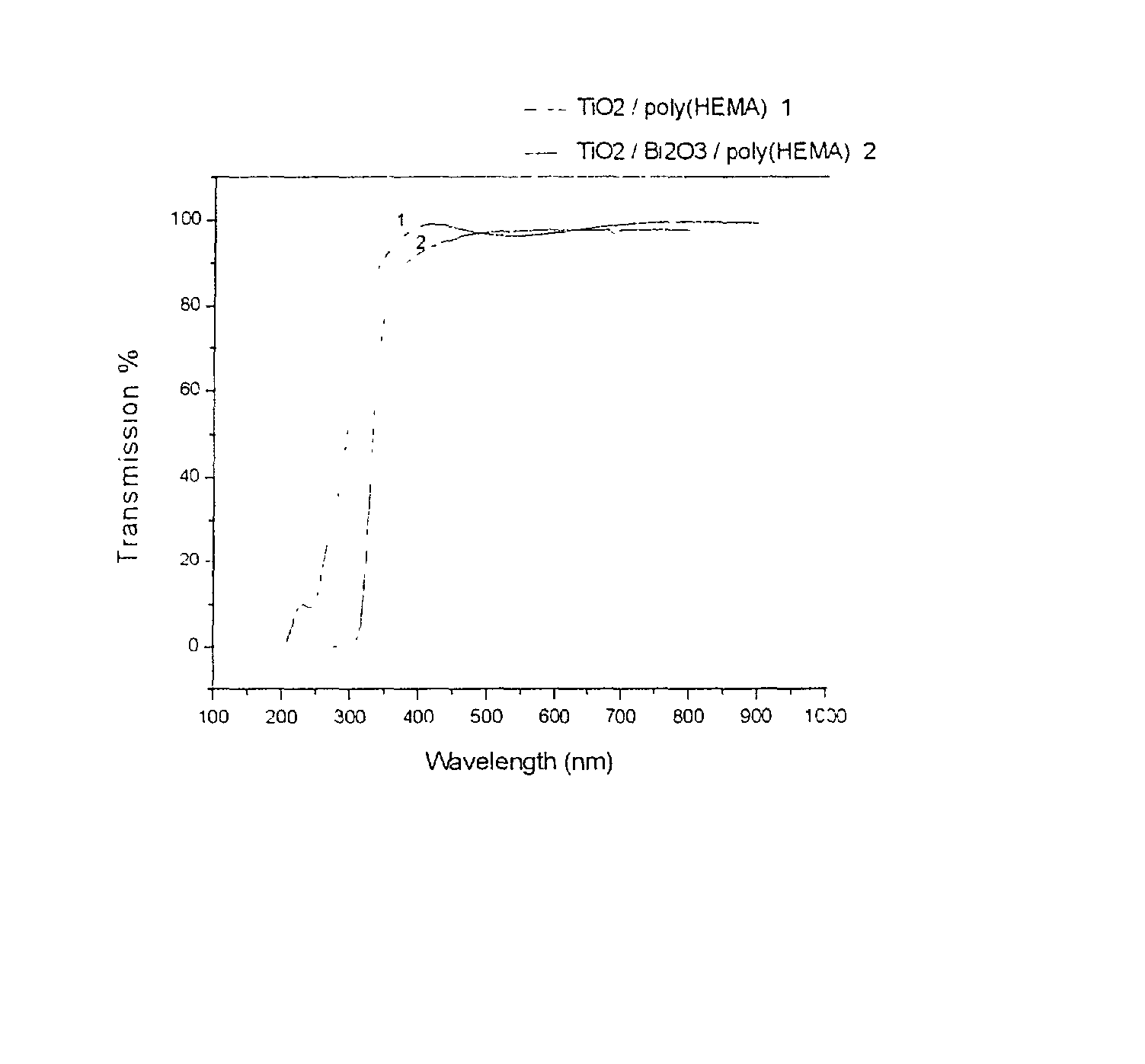Solventless nontoxic high refractive index and low birefringence organic/inorganic hybrid materials
a hybrid material, organic/inorganic technology, applied in the direction of non-metal conductors, iron organic compounds, conductors, etc., can solve the problems of lack of mechanical strength and dimensional stability, unsatisfactory pbs in application, and solve the problem of solving pollution problems, etc., to achieve low birefringence organic/inorganic hybrid materials, high refractive index, and low birefringence
- Summary
- Abstract
- Description
- Claims
- Application Information
AI Technical Summary
Benefits of technology
Problems solved by technology
Method used
Image
Examples
example 1
Preparation of Titanium Methacryl Ethoxide
[0024] In a dry nitrogen glove box, 100 ml of dry tetrahydrofuran, 10.33 grams of titanium n-propoxide were placed in a 250 ml flask and mixed them well at room temperature. The 18.73 grams of hydroxy ethyl methacrylate were added into the mixture and reacted at room temperature. As soon as the solution became golden yellow, a vacuum distillation was used to remove propanol by product. The distillation was continued for 12 hours to remove tetrahydrofuran and propanol completely. A solventless titanium methacryl ethoxide was obtained. The structure of the product was identified by NMR and IR.
example 2
Preparation of Titanium Bismuth Methacryl Ethoxide
[0025] In a dry nitrogen glove box, 1.5 grams of titanium methacrylate ethoxide prepared from example 1, 8.16 grams of hydroxy ethyl methacrylate and 2-3 drops of water were mixed for 10 min in a flask. The 13.5 grams of 1.7.times.10.sup.-4 mole of bismuth methoxy ethoxide in tetrahydrofuran was added into the mixture and reflux at 60.degree. C. for one hour. A vacuum distillation was used to remove tetrahydrofuran and methoxy ethanol by product at room temperature for 8 hours. A solventless titanium bismuth methacryl ethoxide was obtained. The structure of the product was identified by NMR and IR.
example 3
Preparation of Film Sample
[0026] An about 20 grams of 10% (vol.) aqueous hydroxy ethyl methacrylate was added into a mixture of 100 grams (96 gram of metal methacryl ethoxide and 4 gram of 2, 2-dimethoxy-2-phenyl acetophenone (photoinitiator)) to hydrolyze the mixture.
[0027] The exact amount of water used in the hydrolysis was dependent on the gel rate of the mixture. The mixture was hydrolyzed for 2 minutes, and then the hydrolyzed mixture was spin coated on a Si wafer substrate. The sample was irradiated with an UV light (UVP Co. Model UVGL-25) at 254 nm for 3 min. and 365 nm for 3 min to cure the film.
PUM
| Property | Measurement | Unit |
|---|---|---|
| Current | aaaaa | aaaaa |
| Atomic number | aaaaa | aaaaa |
| Birefringence | aaaaa | aaaaa |
Abstract
Description
Claims
Application Information
 Login to View More
Login to View More - R&D
- Intellectual Property
- Life Sciences
- Materials
- Tech Scout
- Unparalleled Data Quality
- Higher Quality Content
- 60% Fewer Hallucinations
Browse by: Latest US Patents, China's latest patents, Technical Efficacy Thesaurus, Application Domain, Technology Topic, Popular Technical Reports.
© 2025 PatSnap. All rights reserved.Legal|Privacy policy|Modern Slavery Act Transparency Statement|Sitemap|About US| Contact US: help@patsnap.com



